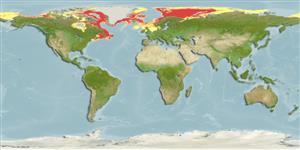Environment: milieu / climate zone / depth range / distribution range
Ökologie
seewasser demersal; tiefenbereich 25 - 1187 m (Ref. 58426). Polar; 84°N - 42°N, 180°W - 180°E
Arctic: Arctic Alaska, Smith Sound, northwest Greenland, Kara Sea, Barents Sea, off Spitsbergen, coast of Norway, Wyville-Thomson Ridge, Iceland, northeast Greenland, and localities off western Greenland.
Size / Gewicht / Alter
Maturity: Lm ? range ? - ? cm
Max length : 44.5 cm SL Männchen/unbestimmt; (Ref. 11976)
Benthic; feeds on crustaceans (Ref. 58426). Switches feeding habits with increasing size. Smaller eelpouts eat mainly endobenthic prey, larger individuals feed more on epibenthic prey (Ref. 13532).
Life cycle and mating behavior
Maturities | Fortpflanzung | Spawnings | Egg(s) | Fecundities | Larven
McAllister, D.E., M.E. Anderson and J.G. Hunter, 1981. Deep-water eelpouts, Zoarcidae, from Arctic Canada and Alaska. Can. J. Fish. Aquat. Sci. 38(7):821-839. (Ref. 11976)
IUCN Rote Liste Status (Ref. 130435)
Bedrohung für Menschen
Harmless
Nutzung durch Menschen
Tools
Zusatzinformationen
Download XML
Internet Quellen
Estimates based on models
Preferred temperature (Ref.
123201): -0.9 - 4, mean 0.8 °C (based on 1789 cells).
Phylogenetic diversity index (Ref.
82804): PD
50 = 0.5000 [Uniqueness, from 0.5 = low to 2.0 = high].
Bayesian length-weight: a=0.00251 (0.00156 - 0.00403), b=3.21 (3.07 - 3.35), in cm total length, based on LWR estimates for this species & Genus-body shape (Ref.
93245).
Trophic level (Ref.
69278): 3.5 ±0.50 se; based on food items.
Widerstandsfähigkeit (Ref.
120179): sehr niedrig, Verdopplung der Population dauert mehr als 14 Jahre. (Preliminary K or Fecundity.).
Fishing Vulnerability (Ref.
59153): Moderate vulnerability (42 of 100).
